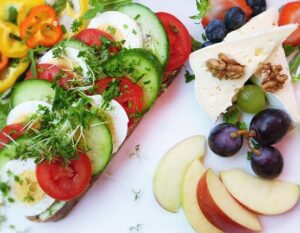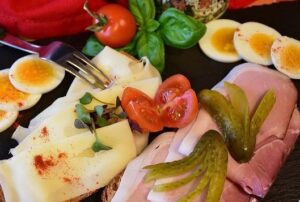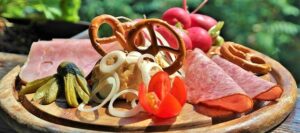Serving a charcuterie board or board dinner is one of many no-cook meal ideas to add to your summer meal options. A charcuterie board is simply a board or tray filled with cold food options. Each person gets to select from a variety of ingredients to make a meal of tasty small bites.
Putting Together a Charcuterie Board Dinner
Start with a large cutting board, flat pan, food tray or cookie sheet. Then load it up with colorful piles of:
Vegetables
Baby carrots, red pepper strips, celery sticks, snap peas, crisp cucumber rounds, and florets of cauliflower or broccoli can be eaten plain, with dip, or rolled in the center of a slice of salami. Thinly slice vegetables like tomatoes or radishes, so they are ready to easily top a small bite.
Fruits
Both fresh and dried fruits work well on a dinner board. Add small clusters of grapes and handfuls of in-season fruits such as berries, or melon slices. Dried fruit options could include dried cranberries, apricots, dates, or diced mango. Fruit can add just the right amount of sweet to balance salty cheeses, meats or spreads.
Condiments
If you want to add condiments or wet foods, such as pickles, jam, dip, mustard, sauce, olives, etc., put them in a small bowl first, rather than putting them directly on the board or pan. This keeps their juices and their flavors contained. Dips and spreads add a flavor boost to raw vegetables. They also and help hold layers of your small bite creations together. Experiment with a small bowl of avocado spread, cream cheese, light ranch dressing or spinach dip.
Whole Grains
Include some whole grain crackers, bread or toasted bread for building the base of your yummy bites.
Protein
 Be sure to leave room for some protein options on the board. Protein choices could include: nuts, nut butters, cheeses, sliced and cooked or cured meats (ham, turkey, beef, salami, etc.), bean spread (hummus), sliced hard-boiled eggs or egg salad.
Be sure to leave room for some protein options on the board. Protein choices could include: nuts, nut butters, cheeses, sliced and cooked or cured meats (ham, turkey, beef, salami, etc.), bean spread (hummus), sliced hard-boiled eggs or egg salad.
Having choices is powerful
Serve up a board of foods with a wide selection of colors, flavors, textures and nutrients. Variety is the key to making this creative no-cook dinner appeal to everyone.
Choice can fuel the creativity and appetite of even the pickiest of eaters!
Food Safety Tips for Serving Board Dinners
- As a reminder, always start with washing hands with soap and water. This is just as important for those helping prepare and place foods on the board/tray, as it is for those who will be helping themselves to the food.
- Gently rub all fresh produce (fruits and vegetables) under cold running water and drain before adding them to the board.
- Prepare foods that need to be kept cold for food safety (meats, cheese, eggs and many dips or spreads) in small bowls or plates and keep them in the refrigerator. Then right before serving add them to the board.
- Have a variety of tongs, spoons, forks or tooth picks in food to help keep hands out of the food.
- Left-overs should be refrigerated within 2 hours of serving or thrown out.

What will you include on your board dinner?
In the comment section, let us know about your creative ideas for a no-cook board dinner, appetizer or dessert.

